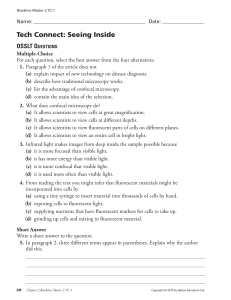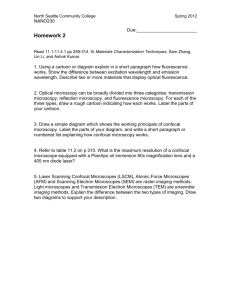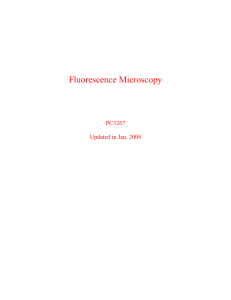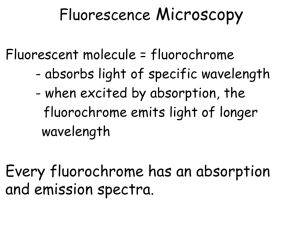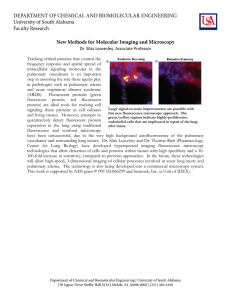HER SOFT MATERIALS O l
advertisement
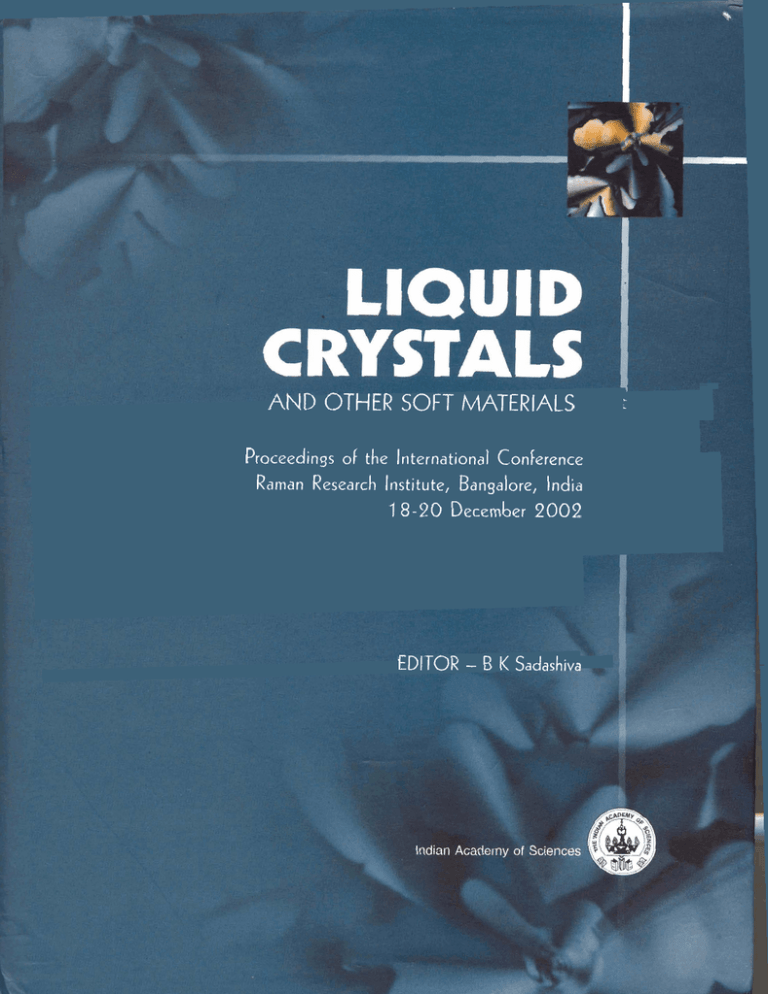
AND O l HER SOFT MATERIALS
Proceedings of the International Conference
Raman Research Institute, Bangalore, India
18-90
December
(LOO2
EDITOR - B K Sadashiva
.-
PRAMANA
@ Indian Academy of Sciences
- journal of
physics
Vol. 61, No. 2
August 2003
pp. 373-384
Fluorescence confocal polarizing microscopy:
Three-dimensional imaging of the director
0 D LAVRENTOVICH
Chemical Physics Interdisciplinary Program and Liquid Crystal Institute, Kent State University,
Kent, Ohio 44242, USA
Email: odl@lci.kent.edu
Abstract. Much of the modem understanding of orientational order in liquid crystals (LCs) is
based on polarizing microscopy (PM). A PM image bears only two-dimensional (2D) information,
integrating the 3D pattern of optical birefringence over the path of light. Recently, we proposed a
technique to image 3D director patterns by fluorescence confocal polarizing microscopy (FCPM).
The technique employs the property of LC to orient the fluorescent dye molecules of anisometric
shape, added in small quantities to the LC. In LC, smooth director deformations do not alter mass
density of the material. Thus the density of dye is also uniform across the sample, except, perhaps,
near the surfaces or at the cores of topological defects. In polarized light, the measured fluorescence
signal is determined by the spatial orientation of the molecules rather than by dye concentration (as
in regular biological samples stained with tissue-specific dyes). The contrast is enhanced when both
excitation and detection of fluorescence light are performed in polarized light. This short review
describes the essence of FCPM technique and illustrates some of its applications, including imaging of Fredenks electric-field induced effect in a nematic LC and defects such as dislocations in
cholesteric LCs.
Keywords. 3D imaging; confocal microscopy; liquid crystals; dislocations.
PACS Nos 07.60.Pb; 61.30.-V;61.30.s; 61.30.Eb; 87.64.Tf
'In my opinion, you cannot say you have thoroughly seen anything until you have a
photograph of it'.
Emile Zola
1. Introduction
Thirty years ago, in the preface to the first edition of The Physics of Liquid Crystals,
P G d e Gennes has written that "...the study of liquid crystals is complicated because
it involves several different scientific disciplines... and also a certain sense of vision in
three-dimensional space in order to visualize complex molecular arrangements" [I]. The
validity of this statement is even greater nowadays, as orientational order pertinent to pure
L C phases is an important feature of other soft-matter materials of physical, chemical and
biological significance. LCs are often used as an ingredient in many composite materials,
such as polymer dispersed and polymer stabilized LCs, colloids with LCs as solvents, etc.
0 D Lavrentovich
The simplest tool to substantiate a sense of three-dimensional (3D) 'molecular arrangements' in materials such as LCs is polarizing microscopy (PM). PM tests the orientation of
optical axes of the LC specimen. Unfortunately, PM yields only 2D textures in the plane
of observation which is perpendicular to the optical axis of the microscope [2-4]. This 2D
image integrates the true 3D configuration of optical birefringence over the path of light
[4]. The director profile along the direction of observation ('vertical cross-section') is hard
to decipher: As illustrated by Bellare et a1 [4], PM images of such varied objects as spheres
and focal conic domains in flat samples of lamellar LCs are practically indistinguishable.
Of course, a sample can be constructed in such a way that it can be viewed from different
sides (a cylindrical capillary, for example), but this solution is not a universal one, as in
most cases researchers are interested in sandwich-like samples with a thin (tens of microns
or less) LC layer confined between two transparent plates. It is precisely the director configuration in the vertical cross-section of such a cell that is the most valuable and desirable
in studies of electro-optic effects such as the Frederiks effect, defects, qurface anchoring,
etc. Note here that not only PM, but also other non-destructive technique's, such as nuclear
magnetic resonance, x-ray diffraction, optical phase retardation, etc., suffer from the same
deficiency: they produce only an integrated image.
Recently, we described a technique that allows one to resolve the compressed dimension
and to obtain truly 3D images of orientational order in LCs, both in the plane of observation and along the direction of observation 15-12]. The technique is based on the confocal
microscopy of LCs doped with anisometric dyes that are aligned by the LC host. In its
refined mode, called the fluorescence confocal polarizing microscopy (FCPM), the sample
is probed with linearly polarized light which allows one to visualiqe regions with different
orientation of the dye which is related to the orientation of the LC director [8-121. However, even in the non-polarized [5-71 or circularly polarized light, the technique is still
capable to resolve the z-component of the director (along the optical axis of the microscope) and some average of the two orthogonal n- and y-components. This review gives
a brief account of FCPM and its simplest applications so far. We start with the general
principles of confocal microscopy.
2. Confocal microscopy
The principle of FCPM imaging is different from the traditional PM and is based on the
confocal microscopy (CM). A CM offers a high 3D spatial resolution of about 1 pm or
better, as it is capable of focusing light into a small volume element (a voxel) [13-161
(figure 1). Besides a special objective with a high numerical aperture (NA) usually in the
range 0.9-1.4, another principal element is a pinhole in front of the detector that functions
as a spatial filter to reduce the signal emerging from outside the selected voxel. Light from
the focal point of the microscope passes through the pinhole, but light from other points
focuses somewhere behind or in front of the screen and thus is effectively blocked by the
disk (only a small fraction of light is transmitted through the pinhole and reaches the detector) (figure 1). The tightly focused light beam scans the sample to obtain a complete
image. The scanning is usually implemented by one focused beam traveling in the horizontal plane and then by mechanical or piezo-element refocusing at a different depth in the
sample. The image is saved as a stack of thin (submicron) horizontal optical slices in the
computer memory. The data then can be presented in a variety of forms, as a 3D pattern
374
Pramana - J. Phys., Vol. 61, No. 2, August 2003
'
,
i
Fluorescence confocal polarizing microscopy
out of focus
7
Pinhole A
Pinhole B-
-
Source
Condenser Sample
Objective
lens
detector
lens
Coi~dcnser
lens
P
,,,
Objective
Pinhole
Sample
Probing light
P
Ar laser
.%urce
Figure 1. (a) A principal scheme of a confocal microscope with two confocal pinholes
for observations in the transmission mode. (b) A principal scheme of a microscope that
allows one to make observations in a regular transmission (non-confocal)mode, using
the left photodetector, and in the reflection confocal fluorescence microscopy mode.
formed by images of all scanned voxels, or as horizontal or vertical 'cross-sections' of the
sample, or in some other form
Fluorescence CM (FCM) is a version of CM in which the specimen is doped with a
high-quantum-yield fluorescent dye that strongly absorbs at the wavelength of the exciting
beam (figure 1 b). The excited dye molecules fluoresce at somewhat longer wavelength.
The difference between the fluorescence and absorption wavelengths is called the Stokes
shift. If the Stokes shift is sufficiently large, the exciting and fluorescence signals can be
effic~entlyseparated by filters so that only the fluorescence light would reach the detector.
If the specimen is heterogeneous, the concentration of the fluorescent probe is coordinatedependent, which results in a high-contrast image (see, for example, refs [17-191). The
FCM technique visualizes features in living cells and tissues; it is successfully applied
in flow cytometry and even for single molecule detection [16]. The advantages of FCM
in condensed matter sciences are also becoming clear, as the technique has been applied
recently to the studies of colloids and polymers [17-251. The fluorophores can selectively
tag a component of interest in mixtures. For example, Held et a1 [22] stained a polymer in
a phase separating monomer-LC mixture; the fluorescent polymer network then helped to
understand the orientation of the surrounding LC
The traditional FCM described above visualizes the concentration (density) distribution
of fluorescence probe in the sample. What is needed in the study of density-homogeneous
materials such as LCs, is to capture the spatial pattern of molecular orientations. By adding
two essential features, namely, polarized light observations and a fluorescent dye composed
Pramana - J. Phys., Voi. 61, No. 2, August 2003
0 D Lavrentovich
'TA:,
Fluorescent
Pinhole
lieht
A
ditector (PMTI)'
'
-
n r Laz
188 nr
Seam
iplitter
'Beam
--,:..--
Director-oriented
fluorophore
XJ
fl
Mercury
, Polarizer P
crvstal cell
with distoAed director
a
Fluorescent
:ransmitted
light detector
(PMTZ)
Figure 2. Fluorescence confocal polarizing microscope used in the present study (see
text).
of anisometric molecules, one transforms the regular FCM into a FCPM that visualizes 3D
director patterns in media with orientational order (figure 2).
!. 1 Busic principles of FCPM
A simple view of how the FCPM in figure 2 visualizes a 3D director field in a nematic
sample is as follows: Imagine a nematic LC doped with a fluorescent dye, such as N, N bis(2,5-di-tert-butylphenyl)-3,3,9,10-perylenedicarboximide(BTBP) (figure 3). Let the
nematic and dye molecules be elongated, as in figure 3. The transition dipoles of both
excitation and fluorescence are assumed to be along the long axis of the dye molecule. As
well known from studies of the so-called 'guest-host' display modes [26], the anisometric
'guest' molecules are aligned by the nematic 'host'. The incident beam causes fluorescence
of the dye (figure 4). For the linearly polarized beam, the efficiency of light absorption is
determined by the angle between its polarization P and the direction of the absorption transition dipole of the dye. The probability of a photon absorption scales as = (cos2 a ) ,where
a is the angle between the transition dipole and P (see figure 4c) and the brackets denote
an average of all orientation of the transition dipole. Similarly, the probability of the emitted photon to reach the detector through the very same polarizer is = (cos2a'),where a'
is the value of a at the moment of emission. Even when the probing and emitted light
beams are passing through the same polarizer, as in the reflective-mode microscope we
used in our studies, the values a' and a might be different. The reason is that the time
Pranmna - J. Phys., Vol. 61, No. 2, August 2003
Fluorescence confocal polarizing microscopy
JH,
CHI
Acndine omge
Figure 3. Molecular structures of fluorescent probes with anisometric shape (elongated in this case) suitable for FCPM imaging of LCs: BTBP and acridine orange.
Both are solvable in thermotropic LCs. When the LC is of a calamitic type (rod-like
molecules), the (average) transition dipole of the dissolved dye molecules is along the
director.
Probing
(b)
(c)
Fluorescent
(dl
Figure 4. PrinEiple of visualizing the director configuration in FCPM. The fluorescent
molecules (ellipsoids) are aligned by the director. Polarized probing beam excites the
dye molecules and cause fluorescence. The efficiency of excitation depends on the
angle between the transition dipole of dye molecule (double-headed arrows) and the
polarization.of the probing beam. The efficiency is minimum in cases (a) and (b),
intermediate in case (c) and mz~xirnumin case (d). The contrast can be enhanced if
the fluorescent light is also routed through a polarizer before reaching a detector. The
detected signal will be maximi~mwhen the polarization of fluorescent light is parallel
to the direction of polarizer.
delay zs between the acts of adsorption and fluorescence emission (called also the lifetime of the dye excited state) might be longer than the characteristic time r,, of rotational
relaxation of the dye in the liquid crystal matrix. Typically, z,
10 ns, while zr is less
than 10 ns; for example, for BTBP molecules in different organic solvents zr 4 ns [ 2 7 ] .
Different scenarios of the I-elationship between zr and 7, and thus different relationships
between the intensity of fluorescent light and orientation of the director with respect to the
polarization of probing light are discussed by Shiyanovskii et u l [ 9 ] .In the reflective-mode
FCPM, the fluorescence signal is rooted through the very same polarizer. If 7,. < ,z, then
a' x a , and the detected fluorescence intensity is related to the angle between the director
-
-
Prarnana J. Phys., Vol. 61, No. 2, August 2003
=
0 D Lavrentovich
and the polarizer direction P, as I cos4 a [9]. The latter relationship indicates a sharper
contrast offered by the FCPM as compared to the traditional PM: in the PM, the intensity
scales as I = sin2 a for a planar liquid crystal cell 1281. Note also that the fluorescence lifetime is sufficiently short to assure that the excited dye molecule remains within the given
voxel. In liquid crystals, the diffusion coefficient for most dye molecules is of the order of
D 10-lo m2/s [26]. Therefore, to travel the distance of the order of 1 1 pm, the dye
molecule would need time z~~~ 1 2 / 0 10 ms, which is much larger than zf. In other
words, the dye molecule will emit within the same voxel in which it was excited.
At this point, a reader might raise an objection about applying the principles of confocal
microscopy to observations of anisotropic media such as LCs. Really, the whole idea of
the confocal microscopy makes sense only if the probing beam can be focused into a small
micron-size voxel. In optically anisotropic media such as LCs, the task is, strictly speaking,
impossible. As soon as the probing beam enters the LC, it gives rise to two propagating
modes, ordinary and extraordinary waves, propagating with different velocities [28] and
thus converging in different regions of the sample. This birefringence-induceddefocusing
will cause blurring of the image.
Although the concern is legitimate, the problem is solvable in practice. The spatial defocusing of the ordinary and extraordinary modes is roughly g(An/n,,)d, where d is the
depth of scanning, g the number of the order of unity that depends on the geometry of light
propagation, director field, objective, etc., An the difference in the refractive indices for extraordinary and ordinary waves, and n,, the average refractive index of the LC. Ford = 20
p m and An = 0.05, the defocusing is of the order of 1 pm; the lower the birefringence An,
the better [8,9]. Therefore, one can always obtain a suitable resolution of the order of 1
p m by working either with relatively thin samples or choosing LC with a relatively small
An.
The following list discusses other important requirements specific to the FCPM imaging of the LC director field [8,9]; of course, the general concerns of regular confocal microscopy (such as light adsorption and scattering, spherical aberrations introduced by cover
slips, etc.) should also be addressed.
-
-
- -
-
(1) Fluorescent probe. The probe should dissolve, align and fluoresce in the anisotropic
host. Different materials (e.g., thermotropic vs. lyotropic LCs) would require different dyes. To study electro-optic phenomena, especially in the DC electric field, one
might wish to avoid dyes of ionic nature as these would redistribute in the electric
field; the intensity pattern might reflect the non-uniform concentration of the ionic
dye rather than the director orientation. The concentration of dye and the intensity of light should also be low enough to avoid light-induced director distortions
in dye-doped LCs, the well-known Janossy effect [29]. Our experiments indicate
that a high-contrast imaging of LCs require a very small quantity of fluorescent dye
(typically 0.01% by weight).
(2) Adiabatic following ofpolarization. In twisted nematic cells or in chiral LCs such as
cholesterics, polarization of both ordinary and extraordinary waves follows the local
director (the so-called Mauguin regime) [28]. This effect must be taken into account
while interpreting the FCPM images for samples with twist deformations, especially
when the twist scale is supra-micron and light propagates along the twist axis. To
avoid this regime, one should reduce the Mauguin parameter [9]
378
Pramana - J. Phys., Vol. 61, No. 2, August 2003
Fluorescence confocal polarizing microscopy
preferably down to ~ 0 . 1 here
;
p is the cholesteric pitch and d the wavelength of
light.
(3) Light scattering. Because of director fluctuations, light scattering in LCs is rather
strong and leads to losses of intensity of both exciting,and fluorescent light. Using
LCs with small An helps to reduce light scattering.
(4) Concentration gradients. Even in a one-component anisotropic medium, there is a
possibility that the dye concentration would be spatially non-uniform as the director
gradients might cause concentration gradients of the dyes. Fortunately, for soluble
dopants the effect is strong only when the scale of distortions is comparable to the
molecular.scale [30]. On the positive side, this feature might be helpful in locating
the cores of topological defects.
The most important advantage of FCPM is that it allows one to collect light from a very
small region of the sample and thus to optically slice the specimen by scanning the focused
beam. Another interesting feature of FCPM is that it is free of n/2 ambiguity known for
PM observations of the LC textures. In PM observations, the optical phase shift is zero and
thus the texture is dark whenever the director is parallel or perpendicular to the polarization
of probing light. Because of this, the PM image cannot distinguish between two mutually
perpendicular director configurations [28]. In FCPM, this ambiguity is avoided. If the
director (and the transition dipole) is parallel to the polarizer, the intensity of detected light
is maximum. If the director is perpendicular to the polarizer, the intensity is minimum.
Figure 2 shows the scheme in which the very same linear polarizer determines polarization of both the incident and the detected fluorescent light. We implemented such a scheme
by modifying the commercially available Olympus Fluoview BX-50 confocal microscope,
namely, by adding a rotating linear polarizer appropriately. Depending on the need, one
can design other polarization geometries, including observations in non-polarized light.
In the latter case, confocal observations are still capable of distinguishing some director
components as illustrated in figure 5 for the fingerprint textures of a cholesteric LC. A
cholesteric LC with a helicoidal director configuration is placed between two plates and
oriented in such a way that the cholesteric 'layers' are perpendicular to the plates and the
helicoidal axis is in the plane of the sample. Even without a polarizer, the confocal microscope is still capable of distinguishing the regions in which the director is vertical and
the regions where it is horizontal or tilted. Clearly, the testing beam propagating along the
vertical z-axis cannot excite vertically oriented dye molecules (in the case of figure 5, the
dye is Rhodamine 590) and the corresponding region looks dark, while the regions with a
non-zero horizontal component of the director are bright.
The need for a polarization-sensitive tool such as FCPM becomes evident when one
attempts to visualize a planar cholesteric texture, with the cholesteric layers parallel to the
bounding plates. These layers can be resolved with a linear polarizer that polarizes both
the incident and the fluorescent beams, as in figure 2. If the Mauguin number (eq. (1))
is sufficiently small, then the horizontal cholesteric layers are resolved as alternating dark
and bright stripes. One can clearly visualize dislocations that run parallel to the glass plates
of the cell (figure 6a).
The unique opportunity to see,what is the director configuration across the LC cell without destroying the sample (as, for example, in scanning electron microscopy) allows one to
;
I
;
Pramnu - J. Phys., Vol. 61, No. 2, August 2003
Figure 5. Fluorescence confocal microscope images of the edge dislocation in a
cholesteric fingerprint texture (a) in the plane of the sample; (b) in the vertical
cross-section, along the line indicated in part (a); the latter image clearly reveals that
the cholesteric layers are missing at the core of the defect, where the director is aligned
vertically. For more details, see [6,7]. Photo courtesy: D Voloschenko.
(b)
Figure 6. FCPM image of the vertical cross-section of cholesteric planar texture with
an edge dislocation gliding towards the top substrate. Polarization of light is perpendicular to the plane of the figure. Mixture of the nematic matrix ZLI3412 and a chiral
agent CB15 with a small addition (0.01% by weight) of the fluorescent dye BTBP.
Photo courtesy: I I Smalyukh: see [I21 for more details.
tackle research problems that are otherwise hardly manageable. For example, one can visualize and reconstruct the three-dimensional structure of kinks along the dislocation lines;
propagation of kinks allows the dislocation such as the edge dislocation in figure 6a to glide
from one level to another within the layered structure [11,12]. Moreover, FCPM demonstrates that the edge dislocation in a lamellar medium such as a short-pitch cholesteric interacts differently with the substrates that have different surface anchoring strength. Figure
6 illustrates the case when the dislocation is repelled from the bottom plate and attracted
to the top plate where it disappears [12].
As FCPM is essentially a non-destructive technique (the quantity of dye is small to cause
significant changes in the LC sample), it allows one to study dynamics of many phenomena, for example, the classic Frederiks transition. Figure 7 shows how the director structure
of the nematic planar sample changes when one increases the voltage applied across the
cell. At some threshold the director starts to deviate from the horizontal orientation towards
Pramana - J. Phys., Vol. 61, No. 2, August 2003
Fluorescence confocal polarizing microscopy
the vertical orientation along the director field. This reorientation starts in the middle of
the cell, as predicted a long time ago [26], but never directly imaged.
Finally, FCPM can visualize not only orientational order but also positional (concentration) patterns in LC systems. In figure 8, a nematic LC is doped with a fluorescent
surfactant and then placed on glycerol. The lens-like LC domains at the glycerol-air interface are clearly seen as stained by the fluorescent surfactant; the concentration of the
surfactant is high at the nematic-glycerol interface and in the nematic bulk but is practically zero in the underlying glycerol. Doping a phase-separating LC-polymer mixture with
a fluorescent dye helped Voloschenko et a1 1101 to trace both the director configuration and
the density distribution of the polymer: in the homogeneous mixture, the dye is distributed
uniformly and is aligned by the director field, but migrates towards the polymer-rich component once the polymerization-induced phase separation begins. In a similar vein, Smalyukh et a1 [31] recently used two different dyes to study both the shape of meniscus and
Relative In!
I,,"
I
-
Figure 7. Frederiks transition imaged by a FCPM in a nematic ZLI3412 doped with
0.01 wt% of BTBA; vertical cross-section of the cell; the black bars correspond to glass
plates. Photo courtesy: I I Smalyukh.
Figure 8. FCPM image of the vertical cross-section of nematic lens-like islands of
5CB doped by a surfactant dye BODIPY C5 (a fluorescent derivative of stearic acid) at
the glycerol-air interface; the fluorescence signal originates from the nematic domains.
The surfactant dye is concentrated mostly in the bulk of the liquid crystal and at its
interfaces with glycerol and air. Photo courtesy: D Termine.
Pramana - J. Phys., Vol. 61, No. 2, August 2003
0 D Lavrentovich
director distribution in freely suspended films of twist grain boundary phases discovered
by Pramod et a1 [32]. In these studies, the shape of the meniscus is traced through the
dye that does not align well in the LC matrix, so that even the regions with a homeotropic
director orientation are visible under FCPM.
3. Discussion
In principle, the FCPM is capable of visualizing real-time dynamics of many phenomena,
as the processes associated with fluorescence are fast. Unfortunately, the current schemes
of scanning are relatively slow. In a standard commercially available confocal microscope,
the optical scanning is performed by a single focused beam. The beam is steered by a
system of mirrors. It takes about 1-10 s to construct an image of a single horizontal plane
in a confocal microscope such as Olumpus Fluoroview BX-50 used in our lab. Vertical
refocusing is achieved by piezoelements. Clearly, the rate of 1 framels is not sufficient
for many research and teaching projects, as dynamics of director structures is often in the
range between 1 ms and 1 s (or even faster, as in the switching of ferroelectric LCs).
Recently, there has been a development in the field of fast-scanning microscopy that
allows one to increase the rate of imaging by three-to-four orders of magnitude, to 1
framelms [33]. It is based on the principle of the rotating Nipkow disk with thousands
of pinholes, a very old (1884) invention, used in early-stages television. The modem addition [33] is that the Nipkow disc with pinholes is supplemented by a coaxial disk with
micro-lenses. The two discs are mechanically connected and are rotated together by an
electrical motor. The micro-lenses focus light onto the pinholes, so that the sample is
scanned by thousands of beams at once. Another way to speed up the scanning process is
to use non-mechanical beam steering devices based on electrically-controlledliquid crystal
optical phase arrays 1341 or diffraction gratings [35]. Note that fast LC cells can be used to
control the polarizer in FCPM.
4. Conclusion
A short characterization of FCPM technique was given by Dierking [36] as the one that
'...literally adds a new dimension to the studies of liquid crystals and similar media by
revealing how the orientation of molecules changes not only in the plane of observations,
but also along the direction of observation...'. Note here that FCPM can be used not only
in the studies of relatively simple and homogeneous samples, but also in the studies of
heterogeneous systems, such as nematic emulsions and dispersed liquid crystals. Such a
work is in progress.
Acknowledgements
The development of FCPM would be impossible without the input of graduate students at
the Chemical Physics InterdisciplinaryProgram, I I Smalyukh, D Voloschenko, undergraduate student D Termine, and my colleagues S V Shiyanovskii and D-K Yang. A part of
382
Pramana - J. Phys., Vol. 61, No. 2, August 2003
Fluorescence confocal polarizing microscopy
this work was supported by the Donors of the Petroleum Research Fund, administered by
ACS, 35306-AC7 and by NSF Science and Technology Center ALCOM DMR89-20147.
References
[I] P G de Gennes and J Prost, The physics of liquid crystals, 1st edition (1974); 2nd edition
(Oxford Univ. Press, Oxford, 1993) p. VII
[2] N H Hartshorn, Microscopy of liquid crystals (Microscope Publications, London, 1974)
[3] G H Meeten (ed.), Optical properties of polymers (Elsevier, Essex, 1986)
[4] J R Bellare, H T Davis, W G Miller and L E Scriven, J. Colloid Interface Sci. 136, 305 (1990)
[5] 0 D Lavrentovich and D-K Yang, ALCOM Symposium on reflective displays, Technical Reports
IX,11 (1997)
[6] 0 D Lavrentovich, S V Shiyanovskii and D Voloschenko, Proceedings of SPIE - The International soclety for optical engineering 3787, 149 (1999)
[7] D Voloschenko and 0 D Lavrentovich, Opt. Lett. 25, 317 (2000)
[8] I I Smalyukh, S V Shiyanovskii and 0 D Lavrentovich, Chem. Phys. Lett. 336,88 (2001)
[9] S V Shiyanovskii, I I Smalyukh and 0 D Lavrentovich, in: Defects in liquid crystals: Compurer simulations, theory and experiment edited by 0 D Lavrentovich, P Pasini, C Zannoni and
S Zumer (Kluwer Academic Publishers, The Netherlands, 2001) vol. 43, pp. 229-270
[lo] D Voloschenko, 0 P Pishnyak, S VShiyanovskii and 0 D Lavrentovich, Phys. Rev. E65,060701
(2002)
[ l 11 I I Smalyukh and 0 D Lavrentovich, Phys. Rev. E66,051703-16 (2002)
[12] I I Smalyukh and 0 D Lavrentovich, Phys. Rev. Lett. 90, 085503 (2003)
[13] T Wilson, Confocal microscopy (Academic Press, London, UK, 1990)
[14] T R Corle and G S Kino, Confocal scanning optical microscopy and related imaging systems
(Academic Press, San Diego, CA, 1996)
[15] C J R Sheppard and D M Shotton, Confocal laser scanning microscopy (BIOS Scientific Publishers, Oxford, 1997)
[16] R H Webb, Rep. Prog. Phys. 59,427 (1996)
[17] W R White and P Wiltzius, Phys. Rev. Lett. 75, 3012 (1995)
[18] J Korlach, P Schwille, W W Webb and G W Feigenson, Proc. Natl. Acad. Sci. USA 96, 8461
( 1999)
[I91 J B Nephew, T C Nihei and S A Carter, Phys. Rev. Lett. 80,3276 (1998)
[20] M H Chestnut, Current Opin. ColloidInterface Sci. 2, 158 (1997)
[21] B V R Tata and B Raj, Bull. Mater. Sci. 21,263 (1997)
[22] G A Held, L L Kosbar, I Dierking, A C Lowe, G Grinstein, V Lee and R D Miller, Phys. Rev.
Lett. 79,3443 (1997)
[23] K Amudson, A van Blaaderen and P Wiltzius, Phys. Rev. E55,1646 (1997)
[24] V J Anderson, E M Terentjev, S P Meeker, J Crain and W C K Poon, Eum. Phys. J. E4, 11
(200 1)
[25] M Srinivasarao, D Collings, A Philips and S Patel, Science 292,79 (2001)
[26] L M Blinov and V G Chigrinov, Electmoptic effects in liquid crystal materials (Springer, New
York, 1993)
[27] W E Ford and P V Kamat, J. Phys. Chem. 91,6373 (1987)
[281 M Kleman and 0 D Lavrentovich, Soji matter physics: An introduction (Springer, New York,
2003)
[29] I Janossy, Phys. Rev. E49,2957 (1994)
[30] S V Shiyanovskii and Ju G Terentieva, Phys. Rev. E49.916 (1994)
P
r
-
m J.
~ Phys., VOI. 61, No. 2, August 2003
383
0 D Lavrentovich
[31] I I Smalyukh, R Pratibha, 0 D Lavrentovich and N V Madhusudana, Liq. Cryst. (2003) (submitted)
[32] P A Pramod, R Pratibha and N V Madhusudana, Curr. Sci. 73,761 (1997); Liq. Cryst. 28,525
(2001)
[33] T Tanaami, S Otsuki, N Tomosada, Y Kosugi, M Shimizu and H Ishida, Appl. Opt. 41. 4704
(2002)
[34] P F McManarnon, T A Dorschner, D L Corkum, L J Friedman, D S Hobbs, M Holz, S Lieberman, H Q Nguyen, D P Resler, R C Sharp and E A Watson, Proc. IEEE 84,268 (1996)
[35] D Subacius, S V Shiyanovskii, P Bos and 0 D Lavrentovich, Appl. Phys. Lett. 71,3323 (1997)
[36] I Dierking, Chem. Phys. Chem. 2,663 (2001)
-
Pramana J. Phys., Vol. 61, No. 2, August 2003
